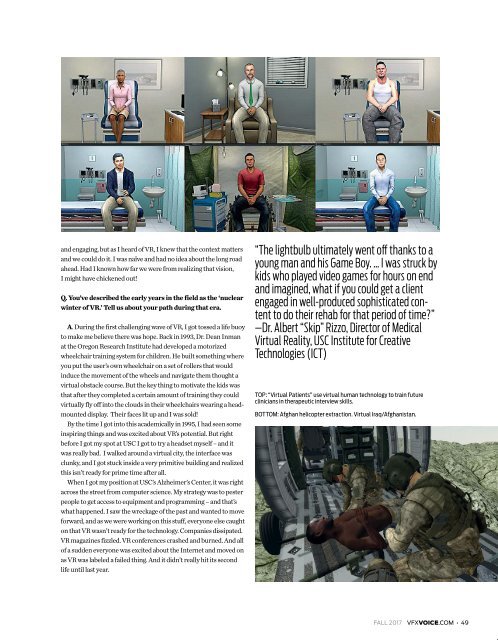Create successful ePaper yourself
Turn your PDF publications into a flip-book with our unique Google optimized e-Paper software.
and engaging, but as I heard of VR, I knew that the context matters<br />
and we could do it. I was naïve and had no idea about the long road<br />
ahead. Had I known how far we were from realizing that vision,<br />
I might have chickened out!<br />
Q. You’ve described the early years in the field as the ‘nuclear<br />
winter of VR.’ Tell us about your path during that era.<br />
A. During the first challenging wave of VR, I got tossed a life buoy<br />
to make me believe there was hope. Back in 1993, Dr. Dean Inman<br />
at the Oregon Research Institute had developed a motorized<br />
wheelchair training system for children. He built something where<br />
you put the user’s own wheelchair on a set of rollers that would<br />
induce the movement of the wheels and navigate them thought a<br />
virtual obstacle course. But the key thing to motivate the kids was<br />
that after they completed a certain amount of training they could<br />
virtually fly off into the clouds in their wheelchairs wearing a headmounted<br />
display. Their faces lit up and I was sold!<br />
By the time I got into this academically in 1995, I had seen some<br />
inspiring things and was excited about VR’s potential. But right<br />
before I got my spot at USC I got to try a headset myself – and it<br />
was really bad. I walked around a virtual city, the interface was<br />
clunky, and I got stuck inside a very primitive building and realized<br />
this isn’t ready for prime time after all.<br />
When I got my position at USC’s Alzheimer’s Center, it was right<br />
across the street from computer science. My strategy was to pester<br />
people to get access to equipment and programming – and that’s<br />
what happened. I saw the wreckage of the past and wanted to move<br />
forward, and as we were working on this stuff, everyone else caught<br />
on that VR wasn’t ready for the technology. Companies dissipated.<br />
VR magazines fizzled. VR conferences crashed and burned. And all<br />
of a sudden everyone was excited about the Internet and moved on<br />
as VR was labeled a failed thing. And it didn’t really hit its second<br />
life until last year.<br />
“The lightbulb ultimately went off thanks to a<br />
young man and his Game Boy. … I was struck by<br />
kids who played video games for hours on end<br />
and imagined, what if you could get a client<br />
engaged in well-produced sophisticated content<br />
to do their rehab for that period of time?”<br />
—Dr. Albert “Skip” Rizzo, Director of Medical<br />
Virtual Reality, USC Institute for Creative<br />
Technologies (ICT)<br />
TOP: “Virtual Patients” use virtual human technology to train future<br />
clinicians in therapeutic interview skills.<br />
BOTTOM: Afghan helicopter extraction. Virtual Iraq/Afghanistan.<br />
FALL <strong>2017</strong> <strong>VFX</strong>VOICE.COM • 49




